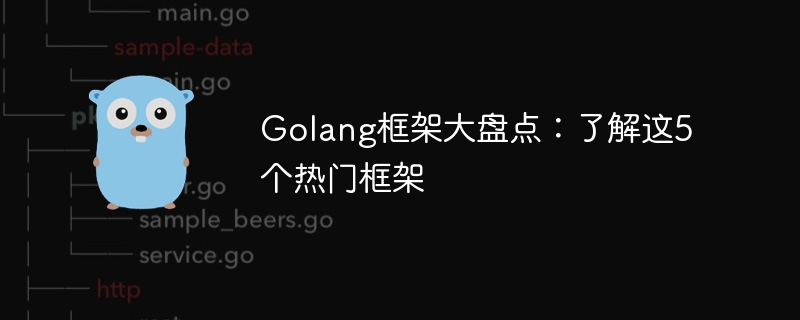Home >Backend Development >Golang >Sorting out Golang framework trends: Understand these 5 popular frameworks
Sorting out Golang framework trends: Understand these 5 popular frameworks
- PHPzOriginal
- 2024-01-24 10:40:08871browse

Golang framework inventory: To understand these 5 popular frameworks, you need specific code examples
Introduction:
Golang is an open source programming language , which has attracted more and more attention in the field of web development in recent years. During the development process, using frameworks can improve development efficiency, simplify the development process, and reduce possible errors. This article will introduce 5 popular Golang frameworks and provide some specific code examples to help readers better understand and use these frameworks.
1. Gin
Gin is a lightweight Web framework that is fast, concise and easy to use. The following is a sample code for creating an HTTP server using the Gin framework:
package main
import "github.com/gin-gonic/gin"
func main() {
// 创建Gin引擎
r := gin.Default()
// 添加一个GET请求处理器
r.GET("/", func(c *gin.Context) {
c.JSON(200, gin.H{
"message": "Hello, world!",
})
})
// 启动HTTP服务器
r.Run(":8080")
}In the above example, we use Gin to create an HTTP server and add a processor to handle GET requests. When running this code, you can get a JSON response that returns "Hello, world!" by visiting http://localhost:8080/.
2. Echo
Echo is another popular web framework that prioritizes speed and simplicity. The following is a sample code for creating an HTTP server using the Echo framework:
package main
import (
"net/http"
"github.com/labstack/echo/v4"
)
func main() {
// 创建Echo实例
e := echo.New()
// 添加一个GET请求处理器
e.GET("/", func(c echo.Context) error {
return c.JSON(http.StatusOK, map[string]string{
"message": "Hello, world!",
})
})
// 启动HTTP服务器
e.Start(":8080")
}In the above example, we use Echo to create an HTTP server and add a processor to handle GET requests. Likewise, when running this code, you can access http://localhost:8080/ to get a JSON response that returns "Hello, world!"
3. Beego
Beego is a full-featured Web framework that is easy to use, high-performance and powerful. The following is a sample code for creating an HTTP server using the Beego framework:
package main
import (
"github.com/astaxie/beego"
)
func main() {
// 创建Beego控制器
type MainController struct {
beego.Controller
}
// 添加一个GET请求处理方法
func (c *MainController) Get() {
c.Data["json"] = map[string]string{
"message": "Hello, world!",
}
c.ServeJSON()
}
// 添加路由映射
beego.Router("/", &MainController{})
// 启动HTTP服务器
beego.Run(":8080")
}In the above example, we use Beego to create an HTTP server and create a controller to handle GET requests. When accessing http://localhost:8080/, a JSON response of "Hello, world!" will be returned.
4. Iris
Iris is a high-performance Web framework that is flexible and easy to use. The following is a sample code for creating an HTTP server using the Iris framework:
package main
import (
"github.com/kataras/iris/v12"
)
func main() {
// 创建Iris实例
app := iris.New()
// 添加一个GET请求处理器
app.Get("/", func(ctx iris.Context) {
ctx.JSON(iris.Map{
"message": "Hello, world!",
})
})
// 启动HTTP服务器
app.Run(iris.Addr(":8080"))
}In the above example, we use Iris to create an HTTP server and add a processor to handle GET requests. When running this code, you can get a JSON response that returns "Hello, world!" by visiting http://localhost:8080/.
5. Revel
Revel is a full-stack Web framework that provides a series of functions and tools to make developing Web applications easier and more efficient. The following is a sample code to create an HTTP server using the Revel framework:
package main
import (
"github.com/revel/revel"
)
// 创建一个控制器
type App struct {
*revel.Controller
}
// 添加一个处理GET请求的方法
func (c App) Index() revel.Result {
return c.RenderJSON(map[string]string{
"message": "Hello, world!",
})
}
func main() {
// 初始化Revel
revel.Init("appName", "dev", revel.LogDefault)
// 添加路由映射
revel.Router.AppController[0] = new(App)
// 启动HTTP服务器
revel.HTTPAddr = "localhost"
revel.HTTPPort = 8080
revel.Run()
}In the above example, we use Revel to create an HTTP server and create a controller to handle GET requests. When accessing http://localhost:8080/, a JSON response of "Hello, world!" will be returned.
Conclusion:
This article introduces 5 popular Golang frameworks and provides some specific code examples to help readers better understand and use these frameworks. As Golang becomes increasingly popular in the field of web development, these frameworks will become important tools for developers, helping them improve efficiency and quality during the development process. Whether it is lightweight Gin or high-performance Iris, these frameworks have their own characteristics and advantages. Choosing the framework that suits your project will be an important decision. I hope readers will have a preliminary understanding of these frameworks through this article and be able to choose a suitable framework for development according to their own needs.
The above is the detailed content of Sorting out Golang framework trends: Understand these 5 popular frameworks. For more information, please follow other related articles on the PHP Chinese website!

